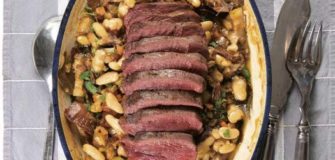The Kitchen: A Journey Through History in Search of the Perfect Design by John Ota
Share
Follow John Ota on IG // Twitter
An excerpt from John Ota’s 2021 Shortlisted book in the Culinary Narratives Category:
“My love for kitchens began at an early age. My happiest childhood memories are of spending time in the kitchen in our family home. I grew up in a working-class neighbourhood in Toronto. My dad built boats and my mom was a high school art teacher. We were not wealthy, but I never felt poor, and the shelves of the refrigerator always groaned from the weight of stews, knishes, dai baos, sushi, coq au vin and lasagnas. We loved to eat. My two younger brothers and I ate so continuously that my dad used to watch in horror as his paycheque was devoured before his eyes.
The kitchen was the hub of the house. All breakfasts, lunches, dinners and snacks were consumed there. But almost more important than the meals, it was also the place of family discussions, talks about holiday plans, hockey games, report cards, politics, hosting neighbours and relatives and my mom’s daily report about her teaching day.
Our kitchen was the opposite of today’s sleek white ideal. It was semi-organized chaos surrounded by loud orange-and-green wallpaper. Flour, sugar, tea and coffee in scratched-up canisters held together with masking tape out on counters; salt, pepper, sugar in open plastic cups by the stove; bottles of olive oil and vinegar everywhere; knives, can openers, bottle openers, rice cooker within easy reach; mountains of cookbooks stacked against the walls. It was a kitchen for cooking in, not for being photographed.
From my architecture and historic preservation studies, and later at work, I found that most people did not share my reverence for the kitchen. Most would ooh and aah over the elaborate architectural details elsewhere in historic houses. I enjoyed those too, but I was always more drawn to the room others ignored. When I told colleagues about my obsession, they would tilt their heads and look at me strangely, as if to say, “You’re not a real preservationist.” To most of them, historical preservation was about the entrance halls, palm rooms and parlours.
I’ve worked in the field of architecture for over forty years, as a writer, designer, historic preservationist and curator, so people often want to talk to me about their house renovations. The first question I ask them is, “What is your perfect kitchen?” It’s the ice breaker. The kitchen is the subject of everyone’s strongest, truest opinions. Without exception, when asked about the kitchen, people express their wants, visions and wish lists to me.
“I’d love a long, sweeping island.”
“I need more counter space.”
“A big stainless steel refrigerator would be wonderful.”
Their real passion is not for the living room or the bathroom or the dining room. Renovations begin in and flow from the kitchen, because it is the centre of everything that happens in the house.
Each of us has a vision of the perfect kitchen. I have designed, written about and fallen in love with small and large kitchens, old and new kitchens, with big budgets and small, for clients and for friends. And I have met people with unique ideas for the perfect kitchen.
In one project, all the building materials, appliances and floor plans were considered with the family dog in mind. I understood. I was a dog in my previous life. On another high-end project, the client specified mirrored tile for the backsplash. When I commented that the mirrored tile might be a problem to keep clean during cooking, she shrugged and replied, “So who cooks?”
Well, I do. Cooking—and eating—are among my greatest pleasures.
I make no great claims for myself as a cook. I mostly rustle up straightforward roasts, soups and salads. But I also love experimenting in unfamiliar (to me) culinary areas (currently, Japanese delicacies like grilled sea bream with miso). My favourite place to be is the kitchen. To me, the kitchen is not just the most important room in my house. It is the centre of my life.
In 2005, my wife, Franny, and I built our own house in a contemporary style. At the time, to control costs, we held back on some nice things for the kitchen. But today our lives have changed. Most evenings we cook at home, our entertaining has happily increased, and although I do most of the cooking, Franny has been doing more.
With both of us spending more time around food, Franny wants to renovate the kitchen. It’s a cramped and crowded space for two people. And while I’ve grown accustomed to its inadequacies, Franny views the room with the critical eye of the newly converted.
It’s awkwardly laid out, she says. Its constituent parts are “not in the right place.”
Let’s face it—my wife hates the kitchen.
I find this disturbing, because I try to keep my wife happy.
And so I embarked on a quest. I decided to explore examples of excellent kitchen designs from throughout North American history in order to learn from them so I could improve our own. I would delve into the origins of the kitchen and examine how its architecture evolved in response to new appliances, cooking methods and the shift from cooking being done by invisible servants in separate buildings to its being the one activity that draws the family together.
And because I wanted to do more than just put together different elements from great kitchens, I began my quest by distilling a raison d’être.
I wrote down the three things I wanted my perfect kitchen to do:
Stimulate creativity: Sriracha, native wild rice, dandelion greens—every time I turn around I want to explore another new ingredient. I need updated kitchen equipment, like a bigger kitchen fan to draw away smoke so that I can blacken catfish. We would experiment more with elaborate dishes like croquembouche if we had laid out our counter more efficiently. I’d love for the kitchento stoke our cooking passion.
Make cooking easier: When we entertain guests we do our best to make sure they have fun. But if the cooking is easier while we’re in the kitchen, we’ll have more fun too.
Encourage celebration: I would love a kitchen that brings people together—laugh, eat, cook, share, connect with memories, feelings and our past. My mom had a cluttered kitchen and more than good food came out of it. I want a kitchen floor we can dance on.
This book and the kitchen it will inspire are gifts to my wife. But this book is also for everyone who loves cooking and eating and wants a better understanding of their kitchen. Or, indeed, wants a better kitchen.
Everybody has something that turns their crank, and while I am honoured to have worked on a variety of building types in my life, including sports domes, museums, art galleries, churches, courthouses and the tiki bar of a pool cabana, my heart has always been in the kitchen.
I especially like historic kitchens. Sometimes, as I walk around them looking at the appliances, the implements, the knick-knacks, I can almost hear the past occupants speaking to me down the centuries.
I love talking to people about their kitchens—the type of sink they chose, the stove, the fridge, the flooring, how they entertain. Most of all, I love talking to people about what they make to eat in there.
Oh, well. I can’t help it. I love kitchens. And I love my wife.
I went in search of our perfect kitchen.”
Excerpted from The Kitchen by John Ota. Copyright © 2020 John Ota. Drawings by John Ota. Published by Appetite by Random House®, a division of Penguin Random House Canada Limited. Reproduced by arrangement with the Publisher. All rights reserved.



